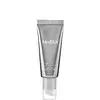What's inside
What's inside
 Key Ingredients
Key Ingredients

 Benefits
Benefits

 Concerns
Concerns

 Ingredients Side-by-side
Ingredients Side-by-side

Water
Skin ConditioningCaprylic/Capric Triglyceride
MaskingGlycerin
HumectantIsododecane
EmollientCetearyl Olivate
Sodium Acrylate/Sodium Acryloyldimethyl Taurate Copolymer
Emulsion StabilisingCyclodextrin
AbsorbentCetearyl Alcohol
EmollientSorbitan Olivate
EmulsifyingTocopheryl Acetate
AntioxidantSqualane
EmollientHydroxyethyl Acrylate/Sodium Acryloyldimethyl Taurate Copolymer
Emulsion StabilisingHydroxyacetophenone
Antioxidant3-O-Ethyl Ascorbic Acid
Skin ConditioningPhenoxyethanol
PreservativeHydroxypropyl Methylcellulose
Emulsion StabilisingSodium Hyaluronate
HumectantTetrahexyldecyl Ascorbate
AntioxidantRubus Chamaemorus Seed Oil
Skin ConditioningPentylene Glycol
Skin ConditioningDaucus Carota Sativa Seed Oil
EmollientRetinal
Skin ConditioningAlumina
AbrasiveIsostearic Acid
CleansingLecithin
EmollientSodium Polyaspartate
HumectantPolyglyceryl-3 Polyricinoleate
EmulsifyingLonicera Japonica Flower Extract
Skin ConditioningLonicera Caprifolium Flower Extract
PerfumingPolyhydroxystearic Acid
EmulsifyingDisodium EDTA
Ethylhexylglycerin
Skin ConditioningStearic Acid
CleansingPolysorbate 60
EmulsifyingSorbitan Isostearate
EmulsifyingBHT
AntioxidantVanilla Planifolia Fruit Extract
Skin ConditioningDipteryx Odorata Bean Extract
MaskingCoumarin
PerfumingCI 14700
Cosmetic ColorantCI 77891
Cosmetic ColorantWater, Caprylic/Capric Triglyceride, Glycerin, Isododecane, Cetearyl Olivate, Sodium Acrylate/Sodium Acryloyldimethyl Taurate Copolymer, Cyclodextrin, Cetearyl Alcohol, Sorbitan Olivate, Tocopheryl Acetate, Squalane, Hydroxyethyl Acrylate/Sodium Acryloyldimethyl Taurate Copolymer, Hydroxyacetophenone, 3-O-Ethyl Ascorbic Acid, Phenoxyethanol, Hydroxypropyl Methylcellulose, Sodium Hyaluronate, Tetrahexyldecyl Ascorbate, Rubus Chamaemorus Seed Oil, Pentylene Glycol, Daucus Carota Sativa Seed Oil, Retinal, Alumina, Isostearic Acid, Lecithin, Sodium Polyaspartate, Polyglyceryl-3 Polyricinoleate, Lonicera Japonica Flower Extract, Lonicera Caprifolium Flower Extract, Polyhydroxystearic Acid, Disodium EDTA, Ethylhexylglycerin, Stearic Acid, Polysorbate 60, Sorbitan Isostearate, BHT, Vanilla Planifolia Fruit Extract, Dipteryx Odorata Bean Extract, Coumarin, CI 14700, CI 77891
 Reviews
Reviews

Ingredients Explained
These ingredients are found in both products.
Ingredients higher up in an ingredient list are typically present in a larger amount.
Disodium EDTA plays a role in making products more stable by aiding other preservatives.
It is a chelating agent, meaning it neutralizes metal ions that may be found in a product.
Disodium EDTA is a salt of edetic acid and is found to be safe in cosmetic ingredients.
Learn more about Disodium EDTAGlycerin is already naturally found in your skin. It helps moisturize and protect your skin.
A study from 2016 found glycerin to be more effective as a humectant than AHAs and hyaluronic acid.
As a humectant, it helps the skin stay hydrated by pulling moisture to your skin. The low molecular weight of glycerin allows it to pull moisture into the deeper layers of your skin.
Hydrated skin improves your skin barrier; Your skin barrier helps protect against irritants and bacteria.
Glycerin has also been found to have antimicrobial and antiviral properties. Due to these properties, glycerin is often used in wound and burn treatments.
In cosmetics, glycerin is usually derived from plants such as soybean or palm. However, it can also be sourced from animals, such as tallow or animal fat.
This ingredient is organic, colorless, odorless, and non-toxic.
Glycerin is the name for this ingredient in American English. British English uses Glycerol/Glycerine.
Learn more about GlycerinSodium Hyaluronate is hyaluronic acid's salt form. It is commonly derived from the sodium salt of hyaluronic acid.
Like hyaluronic acid, it is great at holding water and acts as a humectant. This makes it a great skin hydrating ingredient.
Sodium Hyaluronate is naturally occurring in our bodies and is mostly found in eye fluid and joints.
These are some other common types of Hyaluronic Acid:
Learn more about Sodium HyaluronateWater. It's the most common cosmetic ingredient of all. You'll usually see it at the top of ingredient lists, meaning that it makes up the largest part of the product.
So why is it so popular? Water most often acts as a solvent - this means that it helps dissolve other ingredients into the formulation.
You'll also recognize water as that liquid we all need to stay alive. If you see this, drink a glass of water. Stay hydrated!
Learn more about Water